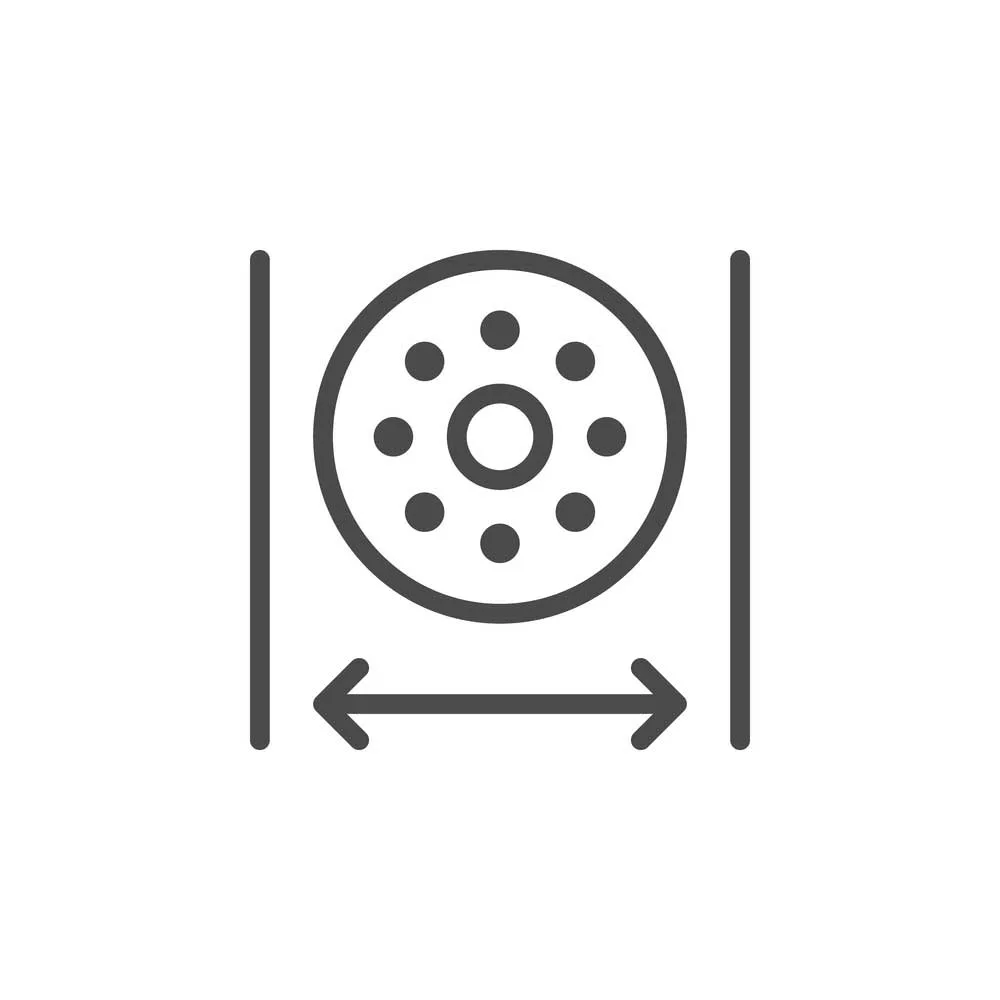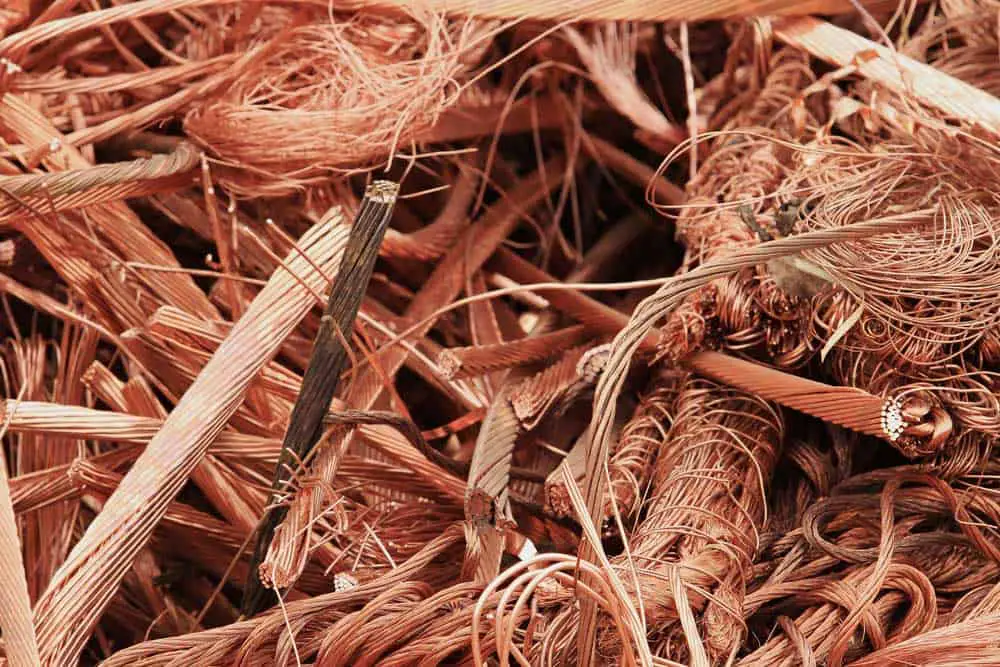When shopping around for electrical wire cables, you’ll notice plenty of sizes to select from. Wire cables are available in different thicknesses, i.e., gauge. Each thickness serves a different purpose.
For that reason, choosing a proper wire size is best when making a new installation. Or even when making extensions or rewiring. Wire conductor sizes should match the circuit’s amperage rating.
So that electrical circuits can go smoothly without overheating the insulation and, thus, fire. So, how do you determine the thickness of wire cables? The AWG cable size chart comes in handy.
Table of Contents
- What is AWG( American Wire Gauge)?
- How to Measure the AWG with the Wire Gauge Tool?
- Calculating Wire Diameter in mm & Inch, Cross-Sectional Area in mm2, inch2 & kcmil & Resistance from AWG Size
- Why are AWG Charts Important?
- AWG Gauge Chart & Table
- Conclusion
What is AWG( American Wire Gauge)?
The American Wire Gauge is a standardized wire gauge system in the US NEC (National Electrical Code) that determines the diameter of an electrical conductor. It determines copper and aluminum wire’s ampacity for electrical wiring installations.
J.R. Brown and Sharpe invented the AWG in 1856, which gives it another name, Brown & Sharpe Gauge.
In an AWG chart, the greater the integers, the smaller the wire sizes. The reverse also applies. The integer sizes include 16-, 14-, 12-, 10-, 8-, 6-, and 2- gauge wire. The wire size dictates the current safety passage through the wire. So, the lower the AWG size, the higher the ampacity, and vice versa.

cable thickness
How to Measure the AWG with the Wire Gauge Tool?
When in the field and you want to estimate the wire gauge, you can use a high-quality device called the wire gauge tool.
To measure the wire gauge, insert the wire in the slots one by one. Shift the wire around the gauge until it fits into the slots. Now, take the reading.
Important: The wire gauge measuring tool lists the popular AWG sizes in a smaller circular disk.
Calculating Wire Diameter in mm & Inch, Cross-Sectional Area in mm2, inch2 & kcmil & Resistance from AWG Size
Once you know the AWG size, you can calculate the wire diameter, cross-sectional area, and resistance based on the following math formula for each. Of course, you can use the wire size calculator for convenience.
Diameter calculations
We calculate a wire’s diameter in millimeters and inches.
To calculate the diameter in millimeters, use the formula below:
Dn = 0.127 × 92(36-n)÷39
To calculate the diameter in inches, use the formula below:
dn (in) = 0.005 in × 92(36-n)/39
Key:
D= The wire diameter
n= Gauge size
Wire cross-sectional area calculations
We calculate a wire’s cross-sectional area in Kcmil, square inches, and millimeters.
To calculate the cross-sectional area of the wire in kilo-circular mils (Kcmil), use the math formula below:
An (kcmil) = 1000×dn2 = 0.025 in2 × 92(36-n)/19.5.
To calculate the cross-sectional area in square inches (in2), use the math formula below:
An (in2) = (π/4)×dn2 = 0.000019635 in2 × 92(36-n)/19.5
To calculate the cross-sectional area in square millimeters (mm2), use the math formula below:
An (mm2) = (π/4)×dn2 = 0.012668 mm2 × 92(36-n)/19.5
Key:
A= The cross-sectional area
n= Gauge size
Wire resistance calculations
We measure resistance in two forms, Ohms per kilofeet (Ω/kft) or Ohms per Kilometer (Ω/km)
To calculate resistance in Ohms per kilofeet (Ω/kft), use the formula below:
Rn (Ω/kft) = 0.3048 × 109 × ρ(Ω·m) / (25.42 × An (in2))
To calculate resistance in Ohms per Kilometer (Ω/km), use the formula below:
Rn (Ω/km) = 109 × ρ(Ω·m) / An (mm2)
Key:
R= The wire resistance
n= Gauge size
Why are AWG Charts Important?
The AWG charts are important in helping electrical experts and professionals determine the cable sizes, resistance, a conductor’s current carrying capacity, and many other parameters. In short, it’s a reference sheet.
- Resistance
Measuring the amount of wire resistance in ohms was quite impossible. But, since 1857, AWG has had this impossibility fixed. The resistance in the AWG chart is for copper wire conductors. To calculate voltage drop, you can apply Ohm’s Law by using the given resistance.
- Ampacity
The key role of the AWG is to determine a conductor’s current rating. In other words, a conductor can safely carry the maximum current carrying capacity without overpowering its temperature rating.
Maximum Frequency for 100% Skin Depth
Skin depth measures the farthest electrical conduction in a conductor. Usually, it’s a function of frequency. This concept is useful in high-frequency AC engineering. When calculating a wire’s resistance, always consider the skin depth effect. According to the AWG chart, the calculated skin depth must equal the radius of the wire.
Breaking Force for Copper Wire
Copper has the highest breaking strength compared to other wire materials, such as aluminum. With that said, you need more force to break it. The amount of force will be dependent on the size and shape of the wire.
Thinner wires are weaker than thicker wires, while longer wires have higher breaking strength than shorter wires. To establish the force f needed to break a piece of copper wire, you’ll need to measure the diameter and length first. The AWG chart and wire gauge tool come in assistance.

Copper wires in different sizes
AWG Gauge Chart & Table
Below is the wire gauge chart (including the wire ampacity chart) showing various data estimations, including wire diameter, cross-sectional wire area, resistance, frequency, and current rating.
| AWG | Diameter (in) | Diameter (mm) | Wire Cross-sectional area (kcmil) | Wire Cross-sectional Area (mm) | Ohms/1000ft | Ohms/km | Max Amp for chassis wiring | Max Amps for power transmission | Max frequency(Skin depth) | Breaking force |
| 0000 (4/0) | 0.46 | 11.684 | 212 | 107 | 0.049 | 0.16072 | 380 | 302 | 125 Hz | 6120 lbs |
| 000 (3/0) | 0.4096 | 10.40384 | 168 | 84.9 | 0.0618 | 0.202704 | 328 | 239 | 160 Hz | 4860 lbs |
| 00 (2/0) | 0.3648 | 9.26592 | 133 | 67.4 | 0.0779 | 0.255512 | 283 | 190 | 200 Hz | 3860 lbs |
| 0 (1/0) | 0.3249 | 8.25246 | 106 | 53.5 | 0.0983 | 0.322424 | 245 | 150 | 250 Hz | 3060 lbs |
| 1 | 0.2893 | 7.34822 | 83.7 | 42.4 | 0.1239 | 0.406392 | 211 | 119 | 325 Hz | 2430 lbs |
| 2 | 0.2576 | 6.54304 | 66.4 | 33.6 | 0.1563 | 0.512664 | 181 | 94 | 410 Hz | 1930 lbs |
| 3 | 0.2294 | 5.82676 | 52.6 | 26.7 | 0.197 | 0.64616 | 158 | 75 | 500 Hz | 1530 lbs |
| 4 | 0.2043 | 5.18922 | 41.7 | 21.1 | 0.2485 | 0.81508 | 135 | 60 | 650 Hz | 1210 lbs |
| 5 | 0.1819 | 4.62026 | 33.1 | 16.8 | 0.3133 | 1.027624 | 118 | 47 | 810 Hz | 960 lbs |
| 6 | 0.162 | 4.1148 | 26.3 | 13.3 | 0.3951 | 1.295928 | 101 | 37 | 1100 Hz | 760 lbs |
| 7 | 0.1443 | 3.66522 | 20.8 | 10.6 | 0.4982 | 1.634096 | 89 | 30 | 1300 Hz | 605 lbs |
| 8 | 0.1285 | 3.2639 | 16.5 | 8.37 | 0.6282 | 2.060496 | 73 | 24 | 1650 Hz | 480 lbs |
| 9 | 0.1144 | 2.90576 | 13.1 | 6.63 | 0.7921 | 2.598088 | 64 | 19 | 2050 Hz | 380 lbs |
| 10 | 0.1019 | 2.58826 | 10.4 | 5.26 | 0.9989 | 3.276392 | 55 | 15 | 2600 Hz | 314 lbs |
| 11 | 0.0907 | 2.30378 | 8.23 | 4.17 | 1.26 | 4.1328 | 47 | 12 | 3200 Hz | 249 lbs |
| 12 | 0.0808 | 2.05232 | 6.53 | 3.31 | 1.588 | 5.20864 | 41 | 9.3 | 4150 Hz | 197 lbs |
| 13 | 0.072 | 1.8288 | 5.18 | 2.63 | 2.003 | 6.56984 | 35 | 7.4 | 5300 Hz | 150 lbs |
| 14 | 0.0641 | 1.62814 | 4.11 | 2.08 | 2.525 | 8.282 | 32 | 5.9 | 6700 Hz | 119 lbs |
| 15 | 0.0571 | 1.45034 | 3.26 | 1.65 | 3.184 | 10.44352 | 28 | 4.7 | 8250 Hz | 94 lbs |
| 16 | 0.0508 | 1.29032 | 2.58 | 1.31 | 4.016 | 13.17248 | 22 | 3.7 | 11 kHz | 75 lbs |
| 17 | 0.0453 | 1.15062 | 2.05 | 1.04 | 5.064 | 16.60992 | 19 | 2.9 | 13 kHz | 59 lbs |
| 18 | 0.0403 | 1.02362 | 1.62 | 0.823 | 6.385 | 20.9428 | 16 | 2.3 | 17 kHz | 47 lbs |
| 19 | 0.0359 | 0.91186 | 1.29 | 0.653 | 8.051 | 26.40728 | 14 | 1.8 | 21 kHz | 37 lbs |
| 20 | 0.032 | 0.8128 | 1.02 | 0.519 | 10.15 | 33.292 | 11 | 1.5 | 27 kHz | 29 lbs |
| 21 | 0.0285 | 0.7239 | 0.810 | 0.412 | 12.8 | 41.984 | 9 | 1.2 | 33 kHz | 23 lbs |
| 22 | 0.0253 | 0.64516 | 0.642 | 0.327 | 16.14 | 52.9392 | 7 | 0.92 | 42 kHz | 18 lbs |
| 23 | 0.0226 | 0.57404 | 0.509 | 0.259 | 20.36 | 66.7808 | 4.7 | 0.729 | 53 kHz | 14.5 lbs |
| 24 | 0.0201 | 0.51054 | 0.404 | 0.205 | 25.67 | 84.1976 | 3.5 | 0.577 | 68 kHz | 11.5 lbs |
| 25 | 0.0179 | 0.45466 | 0.320 | 0.162 | 32.37 | 106.1736 | 2.7 | 0.457 | 85 kHz | 9 lbs |
| 26 | 0.0159 | 0.40386 | 0.254 | 0.128 | 40.81 | 133.8568 | 2.2 | 0.361 | 107 kHz | 7.2 lbs |
| 27 | 0.0142 | 0.36068 | 0.202 | 0.102 | 51.47 | 168.8216 | 1.7 | 0.288 | 130 kHz | 5.5 lbs |
| 28 | 0.0126 | 0.32004 | 0.160 | 0.080 | 64.9 | 212.872 | 1.4 | 0.226 | 170 kHz | 4.5 lbs |
| 29 | 0.0113 | 0.28702 | 0.127 | 0.0647 | 81.83 | 268.4024 | 1.2 | 0.182 | 210 kHz | 3.6 lbs |
| 30 | 0.01 | 0.254 | 0.101 | 0.0507 | 103.2 | 338.496 | 0.86 | 0.142 | 270 kHz | 2.75 lbs |
| 31 | 0.0089 | 0.22606 | 0.0797 | 0.0401 | 130.1 | 426.728 | 0.7 | 0.113 | 340 kHz | 2.25 lbs |
| 32 | 0.008 | 0.2032 | 0.0632 | 0.0324 | 164.1 | 538.248 | 0.53 | 0.091 | 430 kHz | 1.8 lbs |
| 33 | 0.0071 | 0.18034 | 0.0501 | 0.0255 | 206.9 | 678.632 | 0.43 | 0.072 | 540 kHz | 1.3 lbs |
| 34 | 0.0063 | 0.16002 | 0.0398 | 0.0201 | 260.9 | 855.752 | 0.33 | 0.056 | 690 kHz | 1.1 lbs |
| 35 | 0.0056 | 0.14224 | 0.0315 | 0.0159 | 329 | 1079.12 | 0.27 | 0.044 | 870 kHz | 0.92 lbs |
| 36 | 0.005 | 0.127 | 0.0250 | 0.0127 | 414.8 | 1360 | 0.21 | 0.035 | 1100 kHz | 0.72 lbs |
| 37 | 0.0045 | 0.1143 | 0.0198 | 0.0103 | 523.1 | 1715 | 0.17 | 0.0289 | 1350 kHz | 0.57 lbs |
| 38 | 0.004 | 0.1016 | 0.0157 | 0.00811 | 659.6 | 2163 | 0.13 | 0.0228 | 1750 kHz | 0.45 lbs |
| 39 | 0.0035 | 0.0889 | 0.0125 | 0.00621 | 831.8 | 2728 | 0.11 | 0.0175 | 2250 kHz | 0.36 lbs |
| 40 | 0.0031 | 0.07874 | 0.0989 | 0.00487 | 1049 | 3440 | 0.09 | 0.0137 | 2900 kHz | 0.29 lbs |
Conclusion
Selecting a wire with the right thickness is essential in every electrical installation. Whether home-based or industrial-based. All you need is an AWG cable size chart, and your work is made easier.
